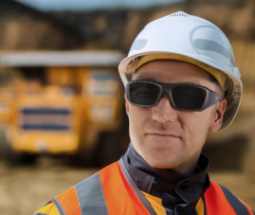Eye Safety at Work
60% of all eye injuries happen in the workplace.
95% of eye injuries are the result of carelessness and lack of attention.
Work-related eye injuries remain an important problem in the Australian workforce. They are a common cause of work-related injury presentation to emergency departments in Australia and result in about 500 admissions to hospital per year.
Protecting Vision,
Whatever the Risk
As the leading manufacturer of prescription lenses in Australia and New Zealand, Essilor is proud to support the efforts of its partner company Prescription Safety Glasses (PSG) in offering superior lens technology and innovation in prescription safety glasses.
PSG's dedication to exceptional quality and devotion to rigorous research and development is evident in every aspect of our Safety Lens category. PSG is passionate about performance, and it shows.
Our prescription safety glasses feature exclusive lens technology within our family of premium brands like Xperio® Polarised and Transitions® adaptive lenses™ from the world's number one lens manufacturer, Essilor.
This helps ensure your employees will experience their best possible vision in all situations while on the job. Then, we combine these technologies with the impact and chemical resistance of rugged polycarbonate materials. The result is workplace eyewear that is durable, accurate, comfortable, and meets all the latest AS/NZS 1337.6, AS/NZ 1337.1 and AS/NZS ISO 21987 standards.
Importance of Prescription Safety Glasses in the Workplace
-
Eye injuries in the workplace are very common, with many people injuring their eyes at work everyday, causing temporary or permanent vision loss.
-
World Health Organization reports on the results of eye injuries:
55 million people annually lose a day's work
19 million suffer unilateral vision loss or blindness
2.3 million suffer bilateral vision loss
1.6 million become blind -
Eye injuries are costly - 900 workers EVERY MINUTE have work-related accidents, 20%-25% of them eye injuries in the US alone (International Labor Organization, US)
-
Common causes of workplace eye injury: Impact, dust, chemicals, heat, visible radiation and UV radiation
Industry Specific Safety Eyewear Needs

Mining Industry
The mining industry has a reputation for being a risky business, with eye safety risks that are varied and often quite serious. It is important for miners to protect themselves accordingly.

Building & Construction Industry
Under constant deadlines, busy construction sites require diligence to maintain eye and vision safety.

Manufacturing Industry
Employees work with milling machines, planers, grinding machines, lathes, threading machines and other production tools putting them at risk of industrial eye injuries.

Oil & Gas Industry
Many workers in the oil and gas industry face inherent safety risks on the job. Some of these risks are especially dangerous to eye health and safety.

Agriculture Industry
Farm activities such as grinding or cutting metal, welding, drilling, animal related tasks and chemical exposures are all potential hazards for eye related injuries.

Aerospace Industry
Aerospace workers face real challenges for eye and vision safety. Our safety eyewear experts can help.

Food Production & Packaging Industry
Constantly running machinery and a variety of materials are a challenge to a worker's vision safety.

Transport, Logistics and Warehousing Industry
Moving vehicles and warehouses are full of potential safety hazards, but employers and workers can minimise these risks by taking proper safety measures.

Utilities Industry
Jobs in various utilities industries can present very real dangers when it comes to eye safety, with hazards including electricity, falling objects, dust and airborne particles, extreme heat and UV exposure.

Pharmaceutical & Health Industry
Safety eyewear helps protects workers from the spectrum of dangers present in their work environment.
Types of Injuries
Types of Eye Injuries
Different types of eye injury include:
- Scratches or cuts
- Punctures
- Embedded objects
- Chemical burns
- Welding flash (vision loss caused by bright light).
Any job that involves airborne particles or hazardous substances carries a risk of eye injury. The eye is extremely delicate and permanent vision loss can result from a relatively minor injury.
Importance of Prescription Safety Glasses in the Workplace
- Always take a common sense approach to hazardous activities and work with your employer to eliminate and control potential eye hazards in the workplace.
- Always wear certified safety eye protection if required. Never wear your normal glasses or sunglasses as a substitute for proper eye protection.
- Make sure you get an eye test to ensure your vision is optimal for your particular work.